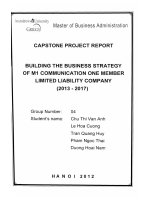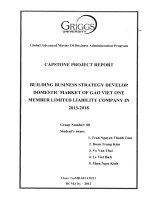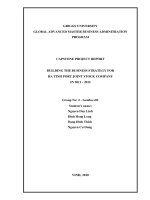Building the business strategy of M1 communication one member limited liability company (2013 - 2017)
Bạn đang xem bản rút gọn của tài liệu. Xem và tải ngay bản đầy đủ của tài liệu tại đây (1.28 MB, 77 trang )
BUILDING THE BUSINESS
STRATEGY OF M1 COMMUNICATION
ONE MEMBER LIMITED LIABILITY COMPANY
(2013 - 2017)
(2013 - 2017)
CAPSTONE PROJECT REPORT
Ho Chi Minh City
Group No.: 4
1. CHU THI VAN ANH
2. LE HOA CUONG
3. TRAN QUANG HUY
4. PHAM NGOC THAI
5. DUONG HOAI NAM
Class: M0111
Capstone Project – M0111 – Group 4
i
TABLE OF CONTENTS
TABLE OF CONTENTS i
LIST OF ABBREVIATIONS iii
LIST OF PICTURES iv
LIST OF TABLES v
ABSTRACT vi
ABSTRACT vi
INTRODUCTION 1
I. The Proposal and Signification of Business Strategy 1
II. The Target of Research 1
III. Objective, Scope and Methodology of Research 2
IV. Research Structure 2
ACKNOWLEDGEMENT 3
CHAPTER 1: THEORY OF STRATEGY MANAGEMENT 4
1. OVERVIEW STRATEGY MANAGEMENT 4
1.1. Defining Strategic Management 4
1.2. Key Term in Strategic Management 6
1.3. Three Stages of Strategic Management process. 8
1.4. The Strategic Management Model 10
2. STRATEGY FORMULATION 12
2.1. Scan External Factor 12
2.1.1 External Opportunities and Threat: 12
2.1.2 Porter Five forces analysis 12
2.1.3 Conduct a Competitive Profile Matrix (CPM). 13
2.1.4 Contrucs an External Factor Evaluation Matrix (EFE). 14
2.2. Scan Internal System 15
2.2.1. Analysis Internal Resources (Internal Audit) 15
2.2.2 Strengths and Weakness: S.W.O.T Matrix, SPACE Matrix, IFE Matrix. 15
2.2.3 Selection the Most Advantages Strategy: QSPM 17
Capstone Project – M0111 – Group 4
ii
3. STRATEGY IMPLEMENTATION AND EVALUATION 18
3.1 Implementing Strategy 18
3.1.1 The Nature of Strategy Implementation 18
3.1.2 Annual Objectives 19
3.1.3 Policies 19
3.1.4 Resource Allocation 20
3.1.5 Managing Conflict 20
3.2 Strategy Review, Evaluation, and Control 21
3.2.1 Describe a practical framework for evaluating strategies. 21
3.2.2 The Balanced Scorecard 23
3.2.3 Contingency Planning 23
CHAPTER 2: M1 COMMUNICATION COMPANY - EXTERNAL AND
INTERNAL ASSESSMENT 25
1. GENERAL INFORMATION OF M1 COMMUNICATION COMPANY 25
1.1. History, Milestone, Organization, Culture History & Milestone 25
1.2. Vision and Culture 26
2. EXTERNAL AND INTERNAL ASSESSMENT 30
2.1 External Opportunities and Threat 30
2.2. The Internal Assessment 48
CHAPTER 3: STRATEGY IMPLEMENTATION AND EVALUATION 56
1. STRATEGY FORMULATION 56
1.1. Analysis of strengths, weaknesses, threats and challenges 56
2. IMPLEMENT STRATEGY AND EVALUATE 63
2.1. Key to Strategy Implement 63
2.2. Resource Allocation 65
2.3. Matching Struture with Strategy 66
CONCLUSION 68
REFERENCES 69
Capstone Project – M0111 – Group 4
iii
LIST OF ABBREVIATIONS
M1 Communication
Company:
M1 Communication One Member Limited Liability
Company
Viettel:
Viettel Group
EFE:
External Factor Evaluation Matrix
CPM:
Competitive Profile Matrix
IFE:
Internal Factor Evaluation Matrix
S.W.O.T:
Strengths, Weakness, Opportunities, Threats Matrix
QSPM:
Quantitative Strategic Planning Matrix
AS :
Attractiveness Score
TAS:
Total Attractiveness Score
Capstone Project – M0111 – Group 4
iv
LIST OF PICTURES
Picture 1: Stages of Strategic Management. 8
Picture 2: Three stage of Strategy Implementation 11
Picture 3: Poter’s Fivee Model 12
Picture 4: M1 Communication Company Organization Chart 27
Picture 5: The population structure of Vietnam in December 2011 32
Picture 6: The five forces model of Michael Porter 42
Picture 7: M1 Company has the model with 5 competitive forces by M. Porter 46
Capstone Project – M0111 – Group 4
v
LIST OF TABLES
Table 1: List of Products 28
Table 2: Competitive Profiles matrix of M1, Samsung and Huawei 40
Table 3: M1 current competitors 44
Table 4: Finance Report (Brief version) 48
Table 5: Cost Structure of Product USB 3G Modem 49
Table 6: Cost Structure of Product Sumo Handset 49
Table 7: Distribution of personnel qualifications 50
Table 8. The QSP Matrix 62
Table 9. Implementation roadmap 67
Capstone Project – M0111 – Group 4
vi
ABSTRACT
The global economy continued to recover since 2008, helped by a sharp growth
in the emerging world. In fact, the emerging world has been largely responsible
for pulling up the advanced world from the depths of the financial apocalypse.
When compared to advanced nations, emerging nations entered the global collapse
with a much lower level of debt, perhaps more important, emerging nations
continue to add to their trade surplus and bank reserves. Thus, emerging nations
remain on the leading edge of economic growth.
In 2012, the global economy continued difficulties, economic downturn occurs
in almost all areas worldwide. According to the World Bank (World Bank) and the
International Monetary Fund (IMF), the global economic crisis will continue to face
many challenges in 2013
Besides many of the services and manufacturing industries are fallen such as
estate, shipbuilding, coal mining, cement so the growth of the Electronic
Manufacturing Industry is a bright spot for the rapid and sustainable development in
Vietnam since 2010. In 2011 with exports of $ 6.89 billion (accounted for 7% of
total exports) and in 2012 (as of 15 October 2012) exports worth more than $9
billion (accounted for 10.2% of total exports).
M1 Communication One Member Limited Liability Company (M1
Communication Company) is a member of the Viettel Group with main business is
producing military communication equipments and consumer electronics products
to continue the development trend of the industry to set up an appropriate strategy
to have one right direction. Strategic planning is built based on external factors and
subjective within the enterprise, systematic analysis of information from which to
establish the orientation, objectives, planning the business activities in the short
term and in the long term, to focus efforts and resources on the main objectives so
that the most effective, response to the uncertain situation, adapt to change.
Recognized that the special importance role of strategic development for the
Capstone Project – M0111 – Group 4
vii
existence and development of the business, our team decided on the topic "Build the
business strategy for M1 Communication One Member Limited Liability Company
in the period 2013 - 2017" with the desire to apply the learned knowledge to
contribute to the sustainable development of the company in the current situation.
Capstone Project – M0111 – Group 4
1
INTRODUCTION
I. The Proposal and Signification of Business Strategy
All companies have a strategy, even if it's not formal, structured and irregular.
All organizations are facing somewhere, but unfortunately some companies do not
know where they went.
The company should have a proactive way rather than just react to the
operating environment, and should attempt to influence, predict and create the
environment rather than just react to the events. Strategic management processes
this. It represents a logical, systematic and objective in determining the future
direction of a business.
The strategic-management process does not end when the company’s leaders
decides what strategy or strategies to pursue. There must be a translation of strategic
thought into strategic action. This translation is much easier if managers and
employees of the firm understand the business, feel a part of the company, and
through involvement in strategy-formulation activities have become committed to
helping the organization succeed. Without understanding and commitment,
strategy-implementation efforts face major problems.
Implementing strategy affects an organization from top to bottom; it affects all
the functional and divisional areas of a business. It is beyond the purpose and scope
of this text to examine all of the business administration concepts and tools
important in strategy implementation.
II. The Target of Research
The Research focus on the following issues:
- The basic theory of strategy and strategy management.
- The analytical models are useful for the formation and strategic selection.
- Current situation of strategic implementation process of M1 Communication
Company in the context of the Vietnam economy.
Capstone Project – M0111 – Group 4
2
- Analyze the internal and external factors that have impact on the strategic
implementation process of the Company.
- Proposed some solutions that is suitable for the Company’s business strategy
in the period 2013-2017.
III. Objective, Scope and Methodology of Research
- Objects and scope: Focuses the current strategy management activities of the
M1 Communication Company and provides solutions in the future.
- Methodology: Research uses two main types of information, which is
primary and secondary information. Secondary information was collected from
many different sources, including significant of which is Business Plans, Finance
Statement.
IV. Research Structure
ABSTRACT
INTRODUCTION
ACKNOWLEDGEMENT
CHAPTER 1: THEORY OF STRATEGY MANAGEMENT
1. OVERVIEW STRATEGY MANAGEMENT
2. STRATEGY FORMULATION
3. STRATEGY IMPLEMENTATION AND EVALUATION
CHAPTER 2: M1 COMMUNICATION COMPANY – EXTERNAL AND
INTERNAL ASSESSMENT
1. GENERAL INFORMATION OF M1 COMMUNICATION COMPANY
CHAPTER 3: STRATEGY IMPLEMENTATION AND EVALUATION
1. STRATEGY FORMULATION
2. IMPLEMENT STRATEGY AND EVALUATE
CONCLUSION
REFERENCES
Capstone Project – M0111 – Group 4
3
ACKNOWLEDGEMENT
We certify that all the content of this project is the effort during the process of
studying, understanding as well as topic selection by the author team members
(besides the reference document and data enclosed).
We hereby acknowledge that this written project has not been collected by any
other studying or training program.
Hanoi, 18
th
November 2012
Capstone Project – M0111 – Group 4
4
CHAPTER 1: THEORY OF STRATEGY MANAGEMENT
1. OVERVIEW STRATEGY MANAGEMENT
1.1. Defining Strategic Management
The Concept of Strategic Management.
Strategic management consists of the analysis, decisions, and actions an
organization undertakes in order to create and sustain competitive advantages. This
definition captures two main elements that go to the heart of the field of strategic
management.
First, the strategic management of an organization entails three ongoing
processes: analysis, decisions, and actions. That is, strategic management is
concerned with the analysis of strategic goals (vision, mission, and strategic
objectives) along with the analysis of the internal and external environment of the
organization. Next, leaders must make strategic decisions. These decisions, broadly
speaking, address two basic questions: What industries should we compete in? How
should we compete in those industries? These questions also often involve an
organization’s domestic as well as its international operations. And last are the
actions that must be taken. Decisions are of little use, of course, unless they are
acted on. Firms must take the necessary actions to implement their strategies. This
requires leaders to allocate the necessary resources and to design the organization to
bring the intended strategies to reality. As we will see in the next section, this is an
ongoing, evolving process that requires a great deal of interaction among these three
processes.
Second, the essence of strategic management is the study of why some firms
outperform others. Thus, managers need to determine how a firm is to compete so
that it can obtain advantages that are sustainable over a lengthy period of time. That
means focusing on two fundamental questions: How should we compete in order to
create competitive advantages in the marketplace? For example, managers need to
determine if the firm should position itself as the low-cost producer, or develop
Capstone Project – M0111 – Group 4
5
products and services that are unique which will enable the firm to charge premium
prices-or some combination of both.
Managers must also ask how to make such advantages sustainable, instead of
highly temporary, in the marketplace. That is: How can we create competitive
advantages in the marketplace that are not only unique and valuable but also
difficult for competitors to copy or substitute?
Michael Porter argues that sustainable competitive advantage cannot be
achieved through operational effectiveness alone. Most of the popular management
innovations of the last two decades-total quality, just-in-time, benchmarking,
business process reengineering, outsourcingall are about operational effectiveness.
Operational effectiveness means performing similar activities better than rivals.
Each of these is important, but none lead to sustainable competitive advantage, for
the simple reason that everyone is doing them. Strategy is all about being different
from everyone else. Sustainable competitive advantage is possible only through
performing different activities from rivals or performing similar activities in
different ways. Companies such.
- Strategic Management can be defined as an art and science to set, implement
and evaluate decisions related to various functions allows an organization to achieve
these goals.
- The Strategic Management process can be described as a practical approach,
rational and systematic to make major decisions in the organization. It aims to
organize information and quality manner to allow decisions to be made in
conditions of uncertainty. However, strategic management is not a pure science
appropriate to approach carefully, closely, step by step.
- The Strategic Management process is based on the belief that the
organization will continue to control events inside and outside to be able to make
changes when necessary. The speed and extent of the changes affecting the
organization is growing rapidly in a scary way. To survive, all organizations must
Capstone Project – M0111 – Group 4
6
be able to acumen to recognize and adapt to change. Strategic Management process
aims to enable organizations to adapt effectively to changes in the long term.
1.2. Key Term in Strategic Management
- Business tasks:
The mission of the business is to set priorities, strategies, plans and the
allocation of work. This is the starting point for setting up task manager and
especially the establishment of the management structure.
Every organization has a single purpose and a reason to exist. The only way
this should be reflected in the report of the task. Nature of business tasks can be
expressed as a competitive advantage or disadvantage of the Company. An
organization will achieve a higher sense of purpose when strategists, managers, staff
development and convey clear business mission.
A good mission statement should show the customer (organization), product,
or service, concern for public image, concern for employees. These basic standards
serve as a framework suitable for evaluating and writing mission statements.
- Assessment of the external factors:
The important influence of the environment can be divided into five main
categories: (1) economic impact; (2) The impact of cultural, social, geographic and
demographic; (3) Effect of law, government and politics; (4) The impact of
technology; (5) The effect of competition. The environmental trends and events
have a huge impact on all of the products, services, and organizations in the world
market.
- Assessment of the Company's internal situation:
Every organization has its strengths and weaknesses in the areas of business.
None of the Company equally strong or weak in all aspects. The strengths /
weaknesses inside along with the opportunities / risks from external and obvious
tasks are the basic points to consider when setting goals and strategies. The
objectives and strategies are designed to take advantage of the strengths and khacp
Capstone Project – M0111 – Group 4
7
gore weaknesses within the internal control region of the strategic management
process.
- Strategic analysis and choice:
Strategic analysis and choice largely subjective decisions based on objective
information. Strategic analysis and choice in order to determine the active process
may choose to ask them which company can complete its responsibilities and
objectives. Strategies, objectives, and current mission of the company plus the
information inside and outside the control will provide the basis for the formation
and evaluation of strategic alternatives feasible.
- Implementation strategy: The management issues.
When the company decided to pursue one or more of the strategy, the strategic
management process does not mean the end. There must be a shift strategic thought
into strategic action. The translation would be a lot easier if the administrators and
staff to understand the company, feel they are part of it, and through active
participation in the implementation of strategy to become attached committed to
helping the company succeed. Without understanding and commitment, strategic
enforcement efforts will encounter many problems.
Implementation strategy: The problem of marketing, finance / accounting,
research and development and information systems.
The strategy does not have a chance to be successful in the organization is not
good marketing their goods and services, or the company does not have sufficient
working capital necessary or at the tech company produce poor quality products, or
in the company information system weaknesses.
Detailed issues including market segmentation, market positioning, evaluate
the usefulness of business, determine the extent to which the debt and / or stock
should be used as a source of capital , preparation of financial statements estimates,
contract research and development with organizations outside the company,
forming a system of information support. The army and the participation of
Capstone Project – M0111 – Group 4
8
administrators and course members will be crucial for the success of the activities of
marketing, finance/accounting, research and development and information systems.
- Evaluation of strategies:
The strategy is too rigid mold and become obsolete when the environmental
conditions inside or outside the company change. So the strategy required to review,
evaluate and adjust the implementation strategy.
Strategic management process results in decisions that can bring significant
long-term results, in contrast to the strategic decision errors can cause a serious
disadvantage and may be very difficult. Therefore, most strategists agree that
strategic assessment is essential to the prosperity of the organization, the timely
assessment can alert administrators to problems or difficulties can occur before a
situation becomes serious. The assessment strategy consists of three basic
operations: (1) control the fundamental basis of the strategy of a company; (2)
Compare the results you want with real results; (3) Receiving function properly for
ensuring that work is carried out in accordance with the plan.
1.3. Three Stages of Strategic Management process.
Picture 1: Stages of Strategic Management.
- Forming strategic phase.
Forming is the process of establishing strategic business tasks, perform
investigations to identify defective elements inside and outside, set long-term goals
and strategic choice between the change world. Sometimes ia the formation of the
strategy is also known as "strategic planning". The difference between strategic
Forming strategic
phase
Phase implementation
strategy
Strategic assessment
period strategy
Planning and
Preparation
Set Direction
Review and
Evaluate
Capstone Project – M0111 – Group 4
9
planning and strategic management strategic management, including the
implementation and evaluation strategies.
Three basic operations in the formation of the strategy is to conduct research,
intuitive harmony and analysis, and decision making. Conduct research related to
the collection and processing of information about the market and the business of
the Company. This process is sometimes referred to as "cursory review business
environment." In essence, the study is important to determine the strengths and
weaknesses in the areas of business functions. Internal factors can be identified as
ways to calculate the ratio, performance measurement, and compared to the
previous period and with the industry average.
- Phase implementation strategy.
Implementation of the strategy is often called the action stage of strategic
management. Implementing means mobilizing administrators and staff to
implement the strategy has been set up.
Three basic operations of the implementation strategy is to establish annual
objectives, policy making, and distribution of resources. Often considered the most
difficult stage in the strategic management process, the implementation of the
strategy requires discipline, dedication and self-sacrifice of the individual.
Successful implementation strategy revolves around its ability to promote the
management staff in the capital is an art rather than a science. The strategy proposed
but not implemented will not serve any useful purpose.
The implementation of the strategy include the development of strategic
funding to support the program, culture and environment while promoting employee
linked reward systems for both the long term and annual goals. Strategic
enforcement activities affect all staff and administrators in organizations.
- Strategic assessment period.
The last phase of strategic management is a strategic assessment. All strategies
depending on the future change because of factors inside and outside the regular
change.
Capstone Project – M0111 – Group 4
10
Three major activities of this phase are: (1) Consider the elements is the basis
for the current strategy; (2) Measurement of achievement, and (3) Implement the
corrective actions. Strategic evaluation period is necessary because the current
success does not guarantee future success. The success always creates new
problems, the organization thought to satisfy the expense of the decline.
The active formulation, implementation and evaluation of strategies occur at
all three levels in a large organization: senior, department or business unit level
strategy, and functional levels. By maintaining information and interaction
relationships between administrators and staff in the ranks, strategic results help for
a functional division of the company into a competitive team. Most small businesses
and some large businesses can not supply parts or strategic business units, so these
organizations have only two levels
1.4. The Strategic Management Model
- The strategic management process can be studied and applied to the use of a
model. Each model represents a certain kind of process.
- Comprehensive strategic management model:
This process is widely accepted. This model does not guarantee success, but it
can make a clear and practical approach in the formulation, implementation and
evaluation of strategies. The relationship between the major components of the
strategic management process is shown in the model.
Capstone Project – M0111 – Group 4
11
Picture 2: Three stage of Strategy Implementation
Define the tasks and objectives, the organization's current strategy is a starting
point meeting in strategic management because the current situation and conditions
of the Company may exclude a number of strategies and even may impose a
specific action. Each organization has a mission, goals and strategies, even if these
factors are not set, written or formal communication.
Strategic management process is dynamic and continuous. A change in any of
the major components in the model may require a change in one or all of the other
components. Strategic management process never really ends.
In fact the process of strategic management are not clearly divided and strictly
implemented as indicated in the model. The strategist does not make the process
step-by-step manner.
Capstone Project – M0111 – Group 4
12
2. STRATEGY FORMULATION
2.1. Scan External Factor
2.1.1 External Opportunities and Threat:
Social, cultural, demographic, and environmental changes have a major impact
on virtually all products, services, markets, and customers. Small, large, for-profit,
and nonprofit organizations in all industries are being staggered and challenged by
the opportunities and threats arising from changes in social, cultural, demographic,
and environmental variables.
For industries and firms that depend heavily on government contracts or
subsidies, political forecasts can be the most important part of an external audit.
Changes in patent laws, antitrust legislation, tac rates, and loobying activities can
affect firms signigicantly. The increasing global interdependence among economies,
markets, governments, and organizations makes it imperative that firms consider the
possible impact of political variables on the formulation and implementation of
competitive strategies.
2.1.2 Porter Five forces analysis
Poter’s Fivee – Forces Model of competitive analysis is a widely used
approach for developing strategies in many industries. The intensity of competition
among firms varies widely across industries. According to Porter, the nature of
competitiveness in a given industry can be viewed as a composite of five forces
Picture 3: Poter’s Fivee Model
Capstone Project – M0111 – Group 4
13
- Rivalry among competing firms.
- Potential entry of new competitors.
- Potential development of substitute products.
- Bargaining power of suppliers.
- Bargaining power of consumers.
The following three steps for using Porter’s Five – Forces Model can indicate
whether competition in a given industry is such that the firm can make an
acceptable profit:
- Identify key aspects or elements of each competitive force that impact the
firm.
- Evaluate how strong and important each element is for the firm.
- Decide whether the collective strength of the elements is worth the firm
entering or staying in the industry.
2.1.3 Conduct a Competitive Profile Matrix (CPM).
Competitive Profile Matrix (CPM) is a strategic management tool which is
used to identify the major strengths and weaknesses of a firm in relation to the
rival’s firm strategic position. On the basis of this comparison, the firm can design
wise offensive or defensive strategies. Two types of systems can be used for the
construction of competitive profile matrix i.e. weighted rating system and
unweighted rating system. It is important to note that the meaning of weights and
total weighted scores is same in both EFE (external factor evaluation) and CPM
(competitive profile matrix).
The Competitive Profile Matrix (CPM) indentifies a firm’s major competitors
and its particular strengths and weaknesses in relatioin to a sample firm’s strategic
position. The weights and total weighted scores in both a CPM and an EFE have the
same meaing. However, critical success factors in a CPM include both internal and
external issues; therefore, the ratings refer to strengths and weaknesses, where 4 =
major strength, 3 = minor strength, 2 = minor weakness, and 1 = major weakness.
The critical success factors in a CPM are not grouped into opportunities and threats
Capstone Project – M0111 – Group 4
14
as they are in an EFE. In a CPM, the ratings and total weighted scores for rival
firms can be compared to the sample firm. This comparative analysis provides
important internal strategic information. Avoid assigning the same rating to firms
included in your CPM analysis.
2.1.4 Contrucs an External Factor Evaluation Matrix (EFE).
An External Factor Evaluation (EFE) Matrix allows strategists to summarize
and evaluate economic, social, cultural, demographic, envionmental, political,
governmental, legal, technological, and competitive information. The EFE Matrix
can be developed in five steps:
- List key external factors as identified in the external – audit process. Include
a total of 15 to 20 factors, including both opportunities and threats, that affect the
firm and its industry. List the opportunities first and then the threats. Be as specific
as possible, using percentages, ratios, and comparative numbers whenever possible.
- Assign to each factor a weight that ranges from 0.0 (not important) to 1.0
(very important). The weight indicates the ralative importance of that factor to being
successful in the firm’s industry. Opportunities often receive higher weights than
threats, but threats can receive high weights if they are especially severe or
threatening. Appropriate weights can be determined by comparing successful with
unsuccessful competitors or by discussing the factor and reaching a group
consensus. The sum of all weights assigned to the factors must equal 1.0.
- Assign a rating between 1 and 4 to each key external factor to indicate how
effectively the firm’s current strategies respond to the factor, where 4 = the response
is superior, 3 = the response is above average, 2 = the response is average, and 1 =
the response is poor. Ratings are based on effectiveness of the firm’s strategies.
Rating are thus company – based, whereas the weights in Step 2 are industry –
based. It is important to note that both threats and opportunities can receive a 1,2,3,
or 4.
- Multiply each factor’s weight by its rating to determine a weighted score.
Capstone Project – M0111 – Group 4
15
- Sum the weighted scores for each variable to determine the total weighted
score for the organization.
2.2. Scan Internal System
2.2.1. Analysis Internal Resources (Internal Audit)
The process of performing an internal audit closely parallels the process of
performing an external audit. Representative managers and employees from
throughout the firm need to be involved in determining a firm’s strengths and
weaknesses. The internal audit requires gathering and assimilating information
about the firm’s management, marketing, finance/accounting,
production/operations, research and development (R&D), and management
information systems operations.
Performing an tinternal audit requires gathering, assimilating, and evaluating
information about the firm’s operations. Some researchers emphasize the
importance of the internal audit part of the strathegic mannagement process by
comparing it to the external audit.
2.2.2 Strengths and Weakness: S.W.O.T Matrix, SPACE Matrix, IFE Matrix.
IFE Matrix:
Internal Factor Evaluation (IFE) matrix is a strategic management tool for
auditing or evaluating major strengths and weaknesses in functional areas of a
business. IFE matrix also provides a basis for identifying and evaluating
relationships among those areas. The Internal Factor Evaluation matrix or short IFE
matrix is used in strategy formulation.
The IFE Matrix together with the EFE matrix is a strategy-formulation tool
that can be utilized to evaluate how a company is performing in regards to identified
internal strengths and weaknesses of a company. The IFE matrix method
conceptually relates to the Balanced Scorecard method in some aspects. IFE Matrix
can be developed in five steps:
- List key internal factors as indentified in the internal-audit process. Use a
total of from 10 to 20 internal factors, including both strengths and weaknesses. List
Capstone Project – M0111 – Group 4
16
strengths first and then weaknesses. Be as specific as possible, using percentages,
ratios, and comparative numbers.
- Assign a weight that ranges from 0.0 (not important) to 1.0 (all-important) to
each factor. The weight assigned to a given factor indicates the relative importance
of the factor to being successful in the firm’s industry. Regardless of whether a key
factor is an internal strength or weakness, factor considered to have the greatest
effect on organizational performance should be assigned the highest weights. The
sum of all weights must equal 1.0.
- Assign a 1-to-4 rating to ech factor to indicate whether that factor represents
a major weakness (rating = 1), a minor weakness (rating = 2) a minor strength
(rating = 3) or a major strength (rating = 4). Note that strengths must receive a 3 or
4 rating and weaknesses must receive a 1 or 2 rating. Ratings are thus company-
based, whereas the weigths in step 2 are industry-based.
- Multiply each factor’s weight by its rating to determine a weighted score for
each variable.
- Sum the weighted scores for each variable to determine the total weighted
score for the organization.
When a key internal factor is both a strength and a weakness, the factor should
be included twice in the IFE Matrix, and a weight and rating should be assigned to
each sratement.
S.W.O.T Matrix:
The Strengths - Weaknesses – Opportunities – Threats - (S.W.O.T) Matrix is
an important matching tool that helps managers develop four types of strategies: SO
(strengths-opportunities) Strategies, WO (weaknesses-opportunities) Strategies, ST
(strengths-threats) Strategies, and WT (weaknesses-threats) Strategies. Matching
key external and internal factor is the most difficult part of developing a S.W.O.T
Matrix and requires good judgment – and there is no one best set of matches.
There are eight steps involved in constructing a S.W.O.T Matrix:
- List the firm’s key external opportunities.
Capstone Project – M0111 – Group 4
17
- List the firm’s key external threats.
- List the firm’s key internal strengths.
- List the firm’s key internal weaknesses.
- Match internal strengths with external opportunities, and record the resultant
SO Strategies in the appropriate cell.
- Match internal weaknesses with external opportunities, and record the
resultant WO Strategies.
- Match internal strengths with external threats, and record the sesultant ST
Strategies.
- Match internal weaknesses with external threats, and record the resultant WT
Strategies.
2.2.3 Selection the Most Advantages Strategy: QSPM
Quantitative Strategic Planning Matrix (QSPM) is a high-level strategic
management approach for evaluating possible strategies. Quantitative Strategic
Planning Matrix or a QSPM provides an analytical method for comparing feasible
alternative actions. The QSPM method falls within so-called stage 3 of the strategy
formulation analytical framework.
The Quantitative Strategic Planning Matrix or a QSPM approach attempts to
objectively select the best strategy using input from other management techniques
and some easy computations. In other words, the QSPM method uses inputs from
stage 1 analyses, matches them with results from stage 2 analyses, and then decides
objectively among alternative strategies.
Stage 1: The first step in the overall strategic management analysis is used to
identify key strategic factors. This can be done using, for example, the EFE matrix
and IFE matrix.
Stage 2: After we identify and analyze key strategic factors as inputs for
QSPM, we can formulate the type of the strategy we would like to pursue. This can
be done using the stage 2 strategic management tools, for example the S.W.O.T









